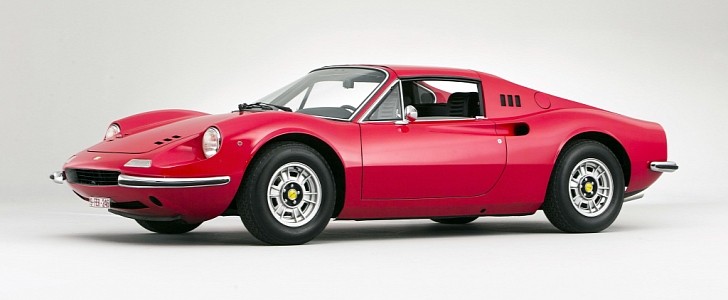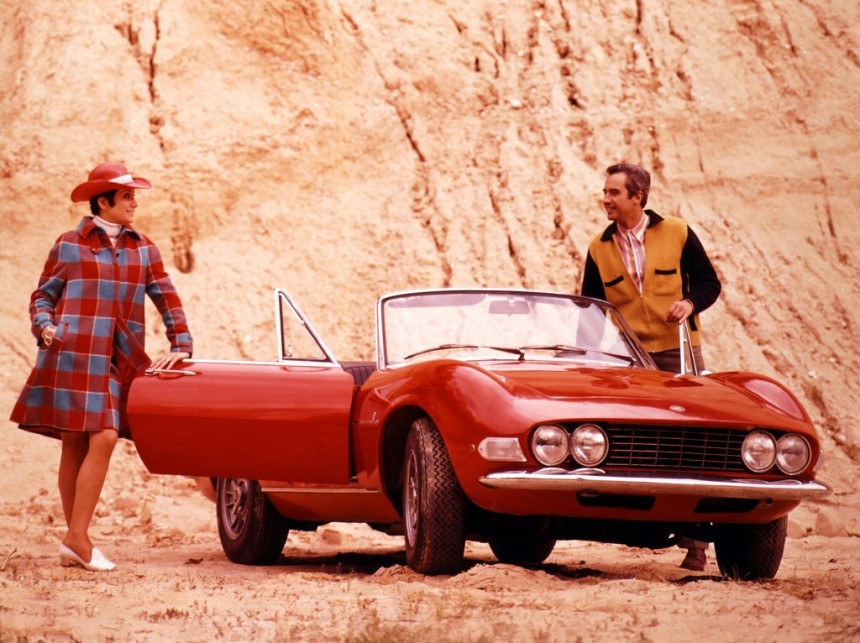Nicknamed Alfredino (as in little Alfredo), Alfredo Ferrari is the gentleman who persuaded Enzo to diversify the Prancing Horse’s engine portfolio. Il Commendatore agreed on a V6 developed by Vittorio Jano, the designer and engineer of a lot of Alfa Romeo, Lancia, and Ferrari racecars.
Enzo’s beloved son didn’t live to see his legacy extend to the Dino sub-brand of mid-engine sports cars, though. Early in his life, Alfredo was diagnosed with Duchenne muscular dystrophy, a severe muscle-wasting disease that primarily affects men. Treatments aren’t exactly up to snuff in 2021 either, which is why Alfredino left us for greener pastures at the age of 24.
During his final days - while hospitalized - the gentleman who’s credited for the 750 Monza discussed technical details of the V6 engine with Vittorio Jano. The day after Alfredo drew his last breath, British racing driver Peter Collins won the French Grand Prix with a black piece of cloth on his arm in mourning. It’s also believed that Enzo Ferrari always wore black ties after Dino’s passing to signify his mourning and never-ending love for Alfredo Ferrari.
To understand how much Enzo loved his first son, the Imola circuit used to be called Autodromo Dino Ferrari. Now known as the Autodromo Internazionale Enzo e Dino Ferrari, the venue saw lots of great racing and tragedies. The San Marino Grand Prix of 1994 comes to mind, a black weekend that saw Roland Ratzenberger crash into a wall at over 310 kph (193 mph) during Saturday qualifying and Ayrton Senna lose control of his car in Tamburello on Sunday.
The V6 that Alfredino was projecting for the very top class of single-seater racing took the drivers’ championship in 1958 in the 246 F1 with Mike Hawthorn behind the wheel. Be that as it may, Enzo waited until 1965 to register the Dino brand name with the Italian Patent and Trademark Office.
What’s the reason behind creating the Dino sub-brand, you ask? For starters, at least 500 road-going cars with the six-cylinder powerplant had to be built to homologate this engine for Formula 2 racing. It’s also worth mentioning that Enzo couldn’t imagine a Ferrari road car without a front-mounted V12 back then. And finally, Il Commendatore was afraid of butter-fingered customers prone to crashing their mid-engine sports cars. By using the Dino sub-brand, strongly mediatized crashes wouldn’t ruin Ferrari’s reputation.
The very first road-going car sold under this nameplate comes from Fiat rather than Ferrari. Offered between 1966 and 1973 in coupe and spider flavors, the front-engined Fiat Dino boasts the 2.0- and 2.4-liter V6 mills that you may know from the 206 GT and 246 series. A total of 7,803 examples were sold, and later units are the most demanded by collectors. According to Hagerty, a 2.4-liter model goes for $55,400 in excellent condition.
Only available as a fixed-head berlinetta, the 206 GT is the rarest Dino of them all with only 152 copies produced until 1969. The 2.0-liter variant was rated at 180 horsepower by Ferrari, which is a little sketchy because Fiat offered 160 horsepower in the Dino and every single powerplant was manufactured by Fiat in Turin rather than Ferrari in Maranello. The call for more power was answered by the 246 GT and 246 GTS, which soldiered on until 1974 with just under 200 horsepower from 2.4 liters of displacement.
Another difference over the 206 GT comes in the guise of steel instead of weight-saving aluminum for the body shell. The longer wheelbase also needs to be highlighted whereas the height is exactly the same at 1,120 millimeters (43.9 inches). All told, the 246 series numbers 3,761 examples.
Previewed by the Stratos Zero concept at the 1970 Turin Motor Show, the Lancia Stratos HF also had a Dino V6 mounted transversally in the middle. Developed from the ground up as a rally car, the Fulvia-replacing model took the constructors’ championship three times on the trot between 1974 and 1976. The road-going Stradale had to be manufactured in extremely limited numbers for the sole purpose of homologation, and 492 units are thought to have left the assembly line at the automaker’s Chivasso factory.
The Dino V6 added two more cylinders in 1973 with the introduction of the 308 GT4, which bore the Dino badge until 1976 when ol’ man Enzo decided that a road-going V8 sports car is worthy of the Prancing Horse. Although the name suggests 3.0 liters and eight cylinders, the first-ever V8 from the Dino family displaces 2,927 cubic centimeters. This engine was continuously developed for the small-displacement 208 GT4, the Mondial, Lancia Thema sports sedan, and Lancia’s LC2 twin-turbocharged racing car.
Even the 288 GTO and F40 are rocking Dino V8s, along with the 348 series, five-valve-per-cylinder F355, and 360. It’s also mandatory for us to remember that Ferrari debuted a Dino-based V12 in the 456, a powerplant that features the same bore and stroke as the 348. The Cavallino Rampante used this lump with the appropriate revisions in the 550, 575, and 612 series, then replaced the Dino-based V12 with the F140 architecture in the Enzo.
During his final days - while hospitalized - the gentleman who’s credited for the 750 Monza discussed technical details of the V6 engine with Vittorio Jano. The day after Alfredo drew his last breath, British racing driver Peter Collins won the French Grand Prix with a black piece of cloth on his arm in mourning. It’s also believed that Enzo Ferrari always wore black ties after Dino’s passing to signify his mourning and never-ending love for Alfredo Ferrari.
To understand how much Enzo loved his first son, the Imola circuit used to be called Autodromo Dino Ferrari. Now known as the Autodromo Internazionale Enzo e Dino Ferrari, the venue saw lots of great racing and tragedies. The San Marino Grand Prix of 1994 comes to mind, a black weekend that saw Roland Ratzenberger crash into a wall at over 310 kph (193 mph) during Saturday qualifying and Ayrton Senna lose control of his car in Tamburello on Sunday.
The V6 that Alfredino was projecting for the very top class of single-seater racing took the drivers’ championship in 1958 in the 246 F1 with Mike Hawthorn behind the wheel. Be that as it may, Enzo waited until 1965 to register the Dino brand name with the Italian Patent and Trademark Office.
What’s the reason behind creating the Dino sub-brand, you ask? For starters, at least 500 road-going cars with the six-cylinder powerplant had to be built to homologate this engine for Formula 2 racing. It’s also worth mentioning that Enzo couldn’t imagine a Ferrari road car without a front-mounted V12 back then. And finally, Il Commendatore was afraid of butter-fingered customers prone to crashing their mid-engine sports cars. By using the Dino sub-brand, strongly mediatized crashes wouldn’t ruin Ferrari’s reputation.
The very first road-going car sold under this nameplate comes from Fiat rather than Ferrari. Offered between 1966 and 1973 in coupe and spider flavors, the front-engined Fiat Dino boasts the 2.0- and 2.4-liter V6 mills that you may know from the 206 GT and 246 series. A total of 7,803 examples were sold, and later units are the most demanded by collectors. According to Hagerty, a 2.4-liter model goes for $55,400 in excellent condition.
Another difference over the 206 GT comes in the guise of steel instead of weight-saving aluminum for the body shell. The longer wheelbase also needs to be highlighted whereas the height is exactly the same at 1,120 millimeters (43.9 inches). All told, the 246 series numbers 3,761 examples.
Previewed by the Stratos Zero concept at the 1970 Turin Motor Show, the Lancia Stratos HF also had a Dino V6 mounted transversally in the middle. Developed from the ground up as a rally car, the Fulvia-replacing model took the constructors’ championship three times on the trot between 1974 and 1976. The road-going Stradale had to be manufactured in extremely limited numbers for the sole purpose of homologation, and 492 units are thought to have left the assembly line at the automaker’s Chivasso factory.
The Dino V6 added two more cylinders in 1973 with the introduction of the 308 GT4, which bore the Dino badge until 1976 when ol’ man Enzo decided that a road-going V8 sports car is worthy of the Prancing Horse. Although the name suggests 3.0 liters and eight cylinders, the first-ever V8 from the Dino family displaces 2,927 cubic centimeters. This engine was continuously developed for the small-displacement 208 GT4, the Mondial, Lancia Thema sports sedan, and Lancia’s LC2 twin-turbocharged racing car.
Even the 288 GTO and F40 are rocking Dino V8s, along with the 348 series, five-valve-per-cylinder F355, and 360. It’s also mandatory for us to remember that Ferrari debuted a Dino-based V12 in the 456, a powerplant that features the same bore and stroke as the 348. The Cavallino Rampante used this lump with the appropriate revisions in the 550, 575, and 612 series, then replaced the Dino-based V12 with the F140 architecture in the Enzo.



























